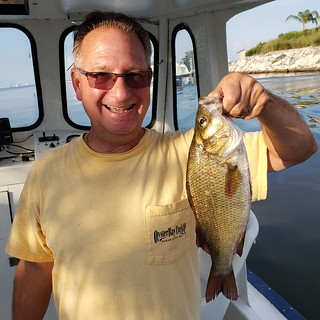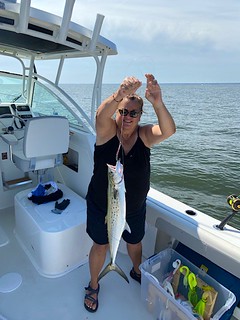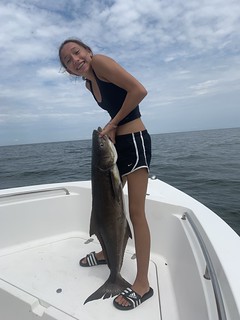Maryland Fishing Report – August 26

Melissa Schworm is all smiles with this beautiful dolphin caught on an Ocean City party boat. Photo by Monty Hawkins
Fishing opportunities abound in Maryland waters from the far western region to the Atlantic Ocean. Whether you are vacationing at Deep Creek Lake or Ocean City, be sure to make fishing part of your vacation plans — you will not regret it.
On Aug. 27 at noon the Maryland Department of Natural Resources hosts its weekly Maryland Fishing Roundtable webinar on summer fishing. Sport Fisheries Advisory Commission member and recreational angler Eric Packard will discuss his fishing adventures throughout southern Maryland and all points in between. Details for joining the webinar are on the department’s online calendar.
All areas of the Chesapeake Bay and tidal rivers are closed to striped bass fishing from Aug. 16 through Aug. 31. This closure is done to lessen catch-and-release mortality that can be caused by high water temperatures and low oxygen values.
This week will see split conditions for the Labor Day holiday. Temperatures will be warmer until Sunday when cooler temperatures take over through Tuesday. Main Bay surface water temperatures have risen back to the low to mid 80s.
Chesapeake Bay gamefish will remain at similar locations on cooler river mouths or main bay structure during the daytime, staying in deeper water, just above the Don’t Fish Below this Depth and maximum suitable oxygen depth, in the coolest water available. The other way to find cooler water continues to be fishing the shallows at first light when surface water temperatures can be several degrees cooler. Recent DNR water monitoring indicates that the coolest, oxygenated water can be found in the deeper waters from the Bay Bridge down to the Virginia state line. For information on Maryland’s bay oxygen conditions, see Maryland’s latest hypoxia report for late July. As always, best fishing areas could be further refined by intersecting these cool, oxygenated areas with underwater points, hard bottom, drop-offs, and large schools of baitfish.
Expect above average flows for the Potomac and Eastern Shore rivers and streams, not including the Susquehanna River. There will be above average tidal currents Saturday through the rest of the week as a result of the full moon on Sept. 2.
To see the latest water clarity conditions on satellite maps, check Eyes on the Bay Satellite Maps.
For more detailed and up-to-date fishing conditions in your area of the bay, be sure to check out Click Before You Cast. Get regular updates on Maryland’s waters sent to your inbox with our Eyes on the Bay newsletter. Sign up online.
The Susquehanna River is experiencing low flows from the Conowingo Dam, which is on an afternoon power generation schedule but has had limited water releases. These conditions offer a unique opportunity to explore the features of the river that are often underwater. Wading and casting into pools can also be fun for flathead, blue, and channel catfish as well as smallmouth bass. Anglers are also fishing at the dam pool for a mix of flathead and channel catfish. Striped bass fishing remains prohibited through Aug. 31.
The tidal rivers and creeks as well as shoal areas of the upper bay are holding populations of white perch that provide plenty of fun light-tackle action as well as some tasty table fare. Few things are as peaceful as drifting along in a small boat casting a beetle spin towards shoreline structure on a quiet summer evening.
In the deeper waters of the bay, shoal areas around Swan Point, the 7-foot and 9-foot knolls and other reefs are holding schools of white perch. They tend to move around so a good depth finder is extremely useful to find suspended perch. Bottom rigs baited with pieces of bloodworm tends to be the most popular way to fish for them.
Blue and channel catfish offer fishing opportunities in the tidal rivers this week. Blue catfish are spread throughout the upper bay and the tidal rivers. The Chester River holds the greatest concentration of blue catfish at this time and the area from Chestertown up past Crumpton are great places to fish for them. Fresh cut baits from gizzard shad or white perch tend to be the easiest baits to acquire. Channel catfish can be found in excellent numbers in all of the tidal rivers as well as out in the bay. Cut baits and clam snouts are popular baits.
Spanish mackerel have moved solidly into the middle bay and anglers can expect to find them along the edges of the shipping channel almost up to the Bay Bridge. The bulk of the action is from the mouth of the Severn River and Poplar Island south. The channel edge near Buoy 83 south to the CP Buoy has been a productive area to troll, as is the shipping channel edge in front of Chesapeake Beach and Breezy Point.
Anglers have been trolling #1 Drone and Clark spoons in gold behind #1 and #2 planers or heavy inline weights at about 7 knots or so. The channel edges are among the best places to explore, and steering a course to the edges of breaking fish and diving seagulls should never be overlooked. Please don’t ever troll through breaking fish, especially when others are casting into them — always go around.
The breaking fish in the region are generally made up of Spanish mackerel, bluefish, and at times 2-year old striped bass chasing bay anchovies. Casting across the breaking fish, allowing your metal jig to sink to a comfortable depth, and then speed reeling is a proven way to catch Spanish mackerel. Make sure you have plenty of jigs since you may get cut off due to all those teeth flashing through the water.
The abundance of speckled trout in the shallower shoreline areas has been a real treat to those who love their light-tackle shallow water action. What could be more fun than casting soft plastics, topwater lures with spinning tackle, or Clousers with a fly rod? Soft plastics in the 4-inch to 5-inch range in pearl and sparkle combinations are popular, Zara Spooks are a blast and finding a large bend in your fly rod is hard to beat. Prominent points with good current flow, grass beds, and stump fields are all good places to check out during the morning and evening hours.
White perch can be found in many of the same locations as the speckled trout. Sometimes you may come across a small puppy drum in the 12-inch to 14-inch range, which is under the minimum slot limit size of 18 inches. Casting beetle spins with spinning gear or small Clousers near shoreline structure is great fun on a summer evening or morning. Simply fishing off a dock or pier is another popular way to fish for white perch, and no casting is involved — the perch are usually tight to the dock piers. Grass shrimp or pieces of bloodworm on a simple bottom rig make the perfect setup.
Catfish offer plenty of action in the tidal rivers. Channel catfish can be found in all of the region’s tidal rivers and fishing with fresh cut bait, clam snouts, or chicken liver is an easy way to catch them. Blue catfish are being caught in the Nanticoke River above Sharptown and in the Choptank River above the Dover Bridge. Blue catfish prefer fresh cut bait, gizzard shad, or white perch often fill the bill.
Spanish mackerel, bluefish, speckled trout, red drum, white perch, and spot are all offering fun fishing. The main stem of the Potomac River is now open to striped bass fishing but the Maryland tributaries are off-limits through Aug. 31.
Spanish mackerel are being caught along the edges of the shipping channel from the Virginia line north to the middle bay, the shipping channel edge from Buoy 72 south to Buoy 68, and the Point Lookout to Cove Point area. Trolling #1 and #2 Drone and Clark spoons in gold behind #1 or #2 planers or heavy inline weights at about 7 knots works well. Trolling blind or near breaking fish or slicks are resulting in limit catches for some anglers, with a daily creel limit of 15 fish per day. Some thought should be given to how many Spanish mackerel go into the fish box since they don’t freeze well and need to be eaten fresh.
Anglers are encountering breaking fish along the edges of the shipping channel and they are mostly a mix of Spanish mackerel and bluefish feeding on bay anchovies. Small striped bass can also be mixed in at times. Casting into the breaking fish with metal jigs and allowing them to sink to an appropriate depth and then speed reeling is another fun way to catch the Spanish mackerel. Slower retrievals will produce bluefish. Anglers are also finding large red drum deep underneath the surface action, and jigging with large soft plastics or spoons is a fun way to get in on some heavy duty catch-and-release action.
Bottom fishing for a mix of spot, white perch, and a speckled trout now and then has been excellent in the lower Patuxent River. The Cornfield Harbor area, Tangier Sound, and lower Hoopers Island are all great places to get in on the action. Pieces of bloodworm are the most popular bait but peeler crab can work well also. Flounder are being found on the shoal edges near channels in the Tangier and Pocomoke sounds this week. Gulp baits and live minnows are popular baits.
Speckled trout are spread throughout the region with much of the best action found on the eastern side of the bay. Casting soft plastics in pearl and sparkle flash near prominent points, marsh edges, and creek mouths is producing good catches. Drifting peeler crab baits near structure and creek mouths is also a great way to fish for speckled trout. Small red drum will be part of the mix, with most measuring under the minimum 18-inch length.
Cobia fishing within the region is slowing down and only a few are being caught in Maryland waters. The best catches of cobia are coming from Virginia waters closer to the mouth of the bay. Sight casting with live eels has been the most successful way to fish for them, but chumming is another alternative.
Blue catfish in the tidal Potomac River or the Nanticoke River offer good fishing for those wishing to anchor up or fish from shore. The blue catfish are plentiful and offer good eating. Most any kind of fresh cut bait works well and many have good luck using clam snouts for bait.
Recreational crabbers are enjoying some of the best crabs of the season and it will get better as September approaches. The crabs have ventured up the tidal rivers and into the upper bay in greater numbers. Most crabbers in the upper bay region are able to catch a half- bushel or more per outing. In the middle and lower bay, catches of a bushel per outing are common.
Razor clams remain the bait of choice whether trotlining or crabbing with collapsible traps. Some of the best crab catches are coming from deep water in the tidal rivers. The shallower areas have a lot of small crabs which will chew up baits and sooks are beginning to be on the move. There will be a major shed coming up in a few weeks, and catches of large crabs will be something to look forward to in September, once they fatten up.
With surface water temperatures in Deep Creek Lake in the low 80s, largemouth and smallmouth bass are most active at night, which translates into early morning and late evening fishing opportunities. Working shallow grass and structure is a good idea, starting with your favorite topwater lures and switching to diving crankbaits and soft plastics during the brighter periods of the day. Bass will be looking for cool shade and they’ll either go to deep grass or the shade of floating docks. Small wacky rigged worms is one way to entice them to pick up an extra midday snack. Crappie are beginning to school up near bridge piers, bluegills can be found near docks, and trout and walleye are deep, often along the dam wall.

Aiden Reilly caught this huge northern snakehead while fishing in the Wicomico River. Photo courtesy of Aiden Reilly
This is a finicky time of the year for smallmouth bass in the upper Potomac. The water levels are down and very clear, so approach is a vital part of successful fishing. Casting topwater lures near flooded shoreline grass is a good tactic in the early morning hours. Switching to small grubs, spinnerbaits, and crankbaits during the day in the deeper parts of the river near ledges and current breaks can work well.
Most trout management waters are running low and clear this week so stealth is very important. Terrestrials such as hoppers, ants, and beetles are a good bet, as are nymphs under an indicator fly. The hatchery crews plan to begin fall trout stocking in October in many of the trout management waters. Anglers are reminded that the stockings will be posted on the trout stocking website or by email after they occur.
Largemouth bass continue their summer pattern of feeding in the shallows at night, and taking a siesta during the day in the coolest and shadiest place they can find. Working the shallower grass areas during the early morning hours or late evenings is a good bet. Topwater lures are one of the best ways to work these shallow and grassy areas; frogs and buzzbaits are good choices.
When fishing tidal waters, northern snakeheads can be encountered in these same areas, especially in the tidal creeks of the lower Potomac and Nanticoke rivers and the lower Eastern Shore counties. When targeting northern snakeheads, a white paddle tail rigged weedless can be deadly when worked close to the surface and worked through grass or near fallen branches and brush.
As the morning wears on, largemouth bass will retreat to cool shade, going deep to some kind of structure or hiding under thick grass, overhanging brush or under docks. Small wacky rigged stick baits or worms worked slowly and patiently is a good way to entice them to pick up a snack. In deep waters a small diving crankbait or grub can also work well.
Fishing for kingfish in the early morning surf has been very good this week, although most report the action tends to fall off by late morning. Pieces of bloodworm have been the most popular bait. A mix of spot and croakers are also part of the mix when fishing with bloodworms. Those fishing with finger mullet or cut mullet are catching bluefish, and flounder can be caught on squid strips.
At the inlet, bluefish are being caught by casting a variety of jigs or drifting cut bait. The evening tides tend to offer some of the best fishing opportunities. Flounder are being caught by drifting traditional baits of squid and minnows or by working Gulp baits close to the bottom.
Fishing for flounder in the channels and their edges in the Back Bay areas continues to be good, in part due to good water clarity. Traditional baits of squid and minnows work well and those looking for the largest flounder are working white or pink Gulp baits or live lining small spot or mullet.

Photo by Monty Hawkins
The boats heading out to the offshore wreck and reef sites are enjoying good sea bass fishing on most days with some limit catches. Those focusing on flounder are catching quite a few large ones. Perhaps the most surprising catches are the numbers of small dolphin being caught around the anchored party boats. These fish have been a real bonus to anglers and some have caught a limit of 10 on their trips.
Further offshore the yellowfin tuna chunk bite at various 30-fathom lumps has fallen off recently. The boats trolling at the canyons are catching a mix of white marlin and a blue marlin now and then. Limits of small dolphin are being caught near lobster buoys and some large ones by trolling. Yellowfin tuna are part of the trolling mix also.
NOAA Fisheries recently implemented new permitting and reporting requirements for recreational tilefish fishermen. All recreational vessel operators (including for-hire operators using their vessels on recreational trips) targeting or retaining golden or blueline tilefish from Virginia to Maine are now required to obtain a free permit from NOAA Fisheries and submit electronic vessel trip reports (eVTRs) within 24 hours of returning to port. A new app has been released to make the reporting process easy and convenient. Harbor Light Software’s eFin Logbook has received certification from NOAA Fisheries as an approved application through which anglers can report their trips. The app is available for use on all Apple and Android mobile devices (iPhone, iPad, Android phone, and Android tablet.)
“A good gamefish is too valuable to be caught only once. The fish you release is your gift to another angler.” — Lee Wulff
Maryland Fishing Report is written and compiled by Keith Lockwood, Maryland Department of Natural Resources fisheries biologist.
Click Before You Cast is written by Tidewater Ecosystem Assessment Director Tom Parham.
This report is now available on your Amazon Echo device — just ask Alexa to “open Maryland Fishing Report.”



